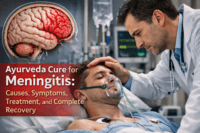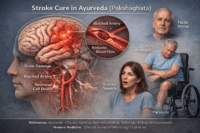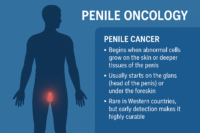What Is Primary CNS Lymphoma?
Primary Central Nervous System Lymphoma is a rare and aggressive type of non-Hodgkin lymphoma that begins inside the brain, spinal cord, eyes, or protective brain membranes [1] [2]. Unlike systemic lymphomas that start in lymph nodes and later spread to the nervous system, this form originates within the central nervous system itself [3].
Because the brain and spinal cord are shielded by the blood brain barrier, cancer cells behave differently here and require specific treatment strategies that can cross this protective barrier [1] [4]. The disease occurs when immune B-cells mutate and grow uncontrollably in these tissues, interfering with major neurologic functions like memory, coordination, vision, and behavior [5] [9].
Symptoms often resemble stroke, infection, or multiple sclerosis, leading to delays in diagnosis if not carefully evaluated [10]. Awareness and timely medical attention are essential to prevent rapid neurological decline.
Who Gets It
Primary CNS Lymphoma most commonly affects adults over fifty, although it can appear at any age [6]. It is seen more frequently in people with weakened immune systems. Individuals living with HIV, organ transplant recipients, and patients receiving long-term immunosuppressive therapy have a higher risk due to reduced immune surveillance [11] [12] [14].
A smaller number of cases arise in people with normal immunity, suggesting that subtle immune regulatory changes or other unknown triggers may contribute [2] [6]. Research continues to explore viral, genetic, and host factors.
Why It Matters
This condition progresses quickly, affecting centers responsible for thinking, vision, personality, and motor control [1] [5]. Even small lesions can lead to severe neurological symptoms because of the brain’s limited space and sensitivity [3].Early diagnosis and high-dose methotrexate-based therapy significantly improve outcomes [2] [4]. Along with conventional oncology care, comprehensive support including cognitive rehabilitation, nutrition, and scientifically aligned Ayurvedic Rasayana strategies can help maintain brain health, immunity, and quality of life [30] [35] [33].
Causes and Risk Factors
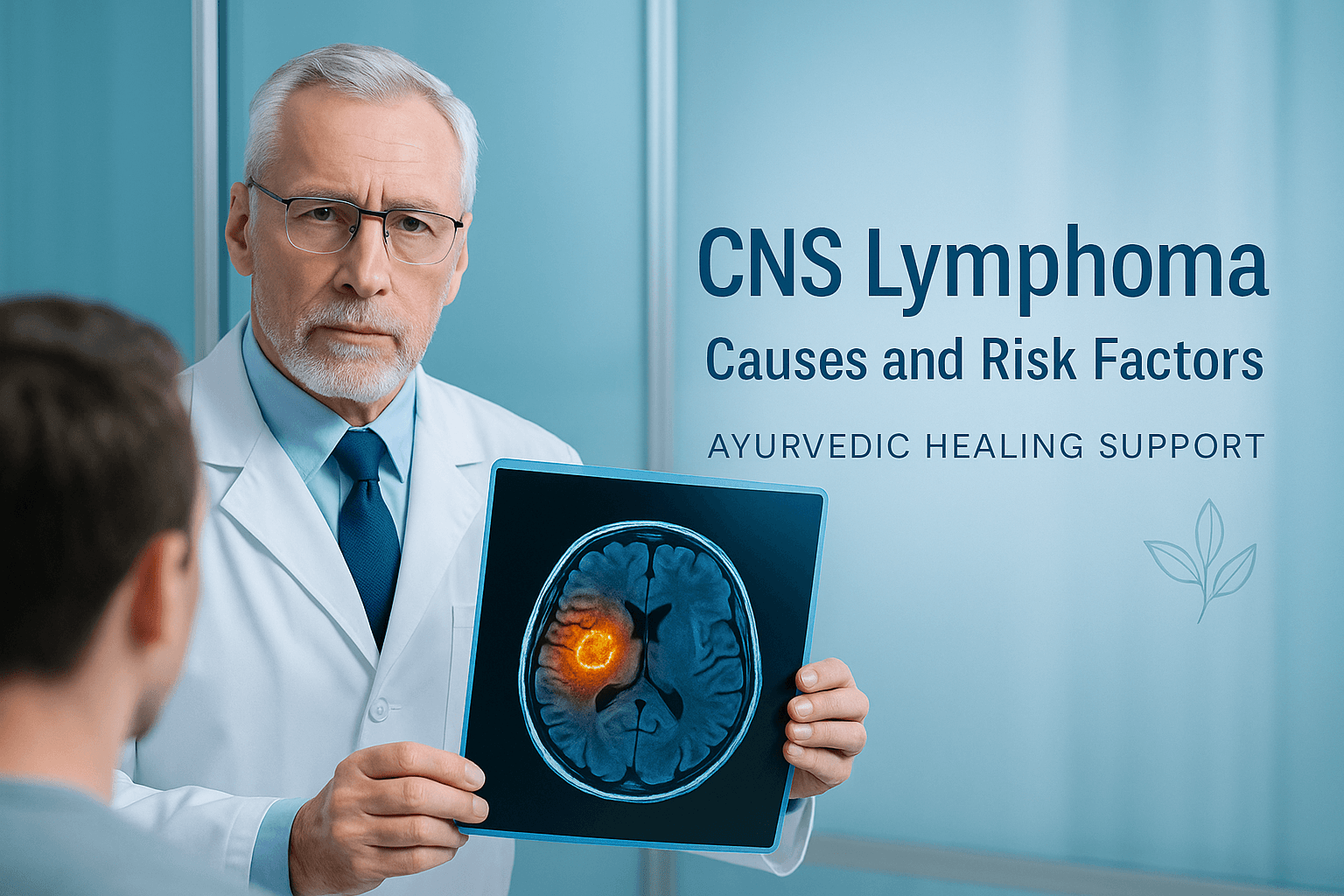
What Causes It
Primary CNS lymphoma arises when B-lymphocytes, a type of immune cell designed to protect the body, undergo malignant transformation within the central nervous system [1] [2]. Unlike systemic lymphomas that begin in lymph nodes and later infiltrate the brain, this disease originates entirely inside the CNS, a space protected by the blood brain barrier. This protective barrier creates a unique biological environment where malignant cells grow differently and require therapies specifically designed to penetrate and act within neural tissue [2] [3].
At the core of this disorder lies a breakdown in immune surveillance. Under normal circumstances, the immune system constantly scans for abnormal cells and removes them. When this protective vigilance weakens, mutated B-cells escape detection and multiply inside the brain or spinal cord [11]. This is one reason Primary CNS lymphoma is strongly linked to states of immune compromise, where the body’s defense system is unable to control rogue cellular activity [14].
The Epstein–Barr virus has also been identified as a contributing driver, particularly in individuals with impaired immunity. EBV infects B-cells and can push them toward malignant behavior when immune control is weakened. In immunocompromised patients, EBV DNA is frequently detected in cerebrospinal fluid and is associated with CNS lymphoma development [12] [13].
In patients with normal immune function, the exact trigger remains complex. Research suggests subtle immune dysregulation, microenvironment shifts within CNS tissues, and genetic susceptibility may create a biological setting where malignant B-cells gain advantage [2] [6]. These cases highlight that CNS lymphoma is not always driven by external infection or overt immunodeficiency but may also arise from deeper immune-metabolic imbalances still being discovered.
Risk Factors
HIV or Severe Immune Weakness
Individuals living with HIV have a significantly increased risk of developing Primary CNS lymphoma because the body’s immune surveillance against abnormal B-cells becomes compromised [11] [14]. Lower CD4 counts and uncontrolled viral replication further raise vulnerability.
Organ Transplant Recipients
Transplant patients often require lifelong immunosuppressive medicines to prevent organ rejection. This reduced immune activity creates an opportunity for latent viruses, including EBV, to reactivate and drive malignant lymphocyte expansion inside the CNS [12].
Long-Term Immunosuppressive or Steroid Therapy
Chronic corticosteroid use and long-term immune-modulating therapies used in autoimmune disorders weaken the body’s internal cancer-watch system. Over time, this can increase the risk of CNS-localized lymphoid malignancy [11] [14].
Possible Genetic and Immune-Regulatory Predisposition
A subset of patients develops Primary CNS lymphoma without HIV, immunosuppressive therapy, or known viral contribution. In such cases, emerging evidence suggests genetic variations affecting immune regulation, B-cell pathways, or CNS microenvironment signals may create vulnerability [6] [2]. While not fully defined, this highlights the evolving understanding that CNS lymphoma can arise from both obvious and subtle pathways of immune imbalance.
Symptoms

Brain-Related Symptoms
Because Primary CNS Lymphoma primarily affects the brain, neurological symptoms are often the earliest signs. Many patients experience persistent headache, nausea, or vomiting due to increased intracranial pressure as the tumor grows [1] [2].
As the disease infiltrates specific brain regions, changes in behavior, irritability, or personality shifts may appear, often mistaken for psychiatric illness or age-related decline [3] [5].
Confusion, memory loss, or difficulty concentrating are common, reflecting involvement of the cerebral hemispheres and limbic system [4] [6].
Weakness or numbness affecting one side of the body occurs when the tumor interferes with motor or sensory pathways [5] [9].
Some patients develop seizures, particularly when the lesion irritates the cortical surface or spreads near the temporal or frontal lobes [7] [10].
From an Ayurvedic perspective, these manifestations correspond to Majja Dhatu Dushti and Vata aggravation within the nervous system channels (Majjavaha Srotas). Rasayana therapies that strengthen Ojas and stabilize Majja can help reduce recurrence and support post-treatment recovery.
Eye Symptoms (Ocular Lymphoma)
When the lymphoma involves the eyes—a condition known as ocular lymphoma—visual disturbances become prominent. Patients may complain of blurred or double vision, difficulty focusing, or intermittent visual distortion [11] [12].
Some experience eye pain, swelling, or redness, often misdiagnosed as chronic uveitis or infection [13] [14].
In advanced stages, floaters or progressive vision loss may occur due to retinal or vitreous infiltration [15].
Ocular involvement can precede, accompany, or follow brain lesions. Ayurvedically, this indicates derangement of Alochaka Pitta, requiring ocular-specific Rasayana and netra-poshana (eye-rejuvenating) herbs such as Triphala and Yashtimadhu.
Spine-Related Symptoms
When lymphoma extends to the spinal cord or meninges, symptoms shift to the lower body. Chronic back pain is an early indication, often due to compression of spinal roots [16] [17].
As the disease progresses, patients may notice leg weakness, imbalance, or difficulty walking, signaling cord involvement [18].
In late stages, loss of bowel or bladder control can occur due to advanced spinal infiltration, requiring urgent intervention [19].
From the Ayurvedic lens, this correlates with Apana Vata vitiation and obstruction in Mamsa and Majja Srotas, for which therapies focusing on nerve nourishment (like Ashwagandha, Kapikacchu, and medicated ghee formulations) are often supportive adjuncts.
How It Is Diagnosed
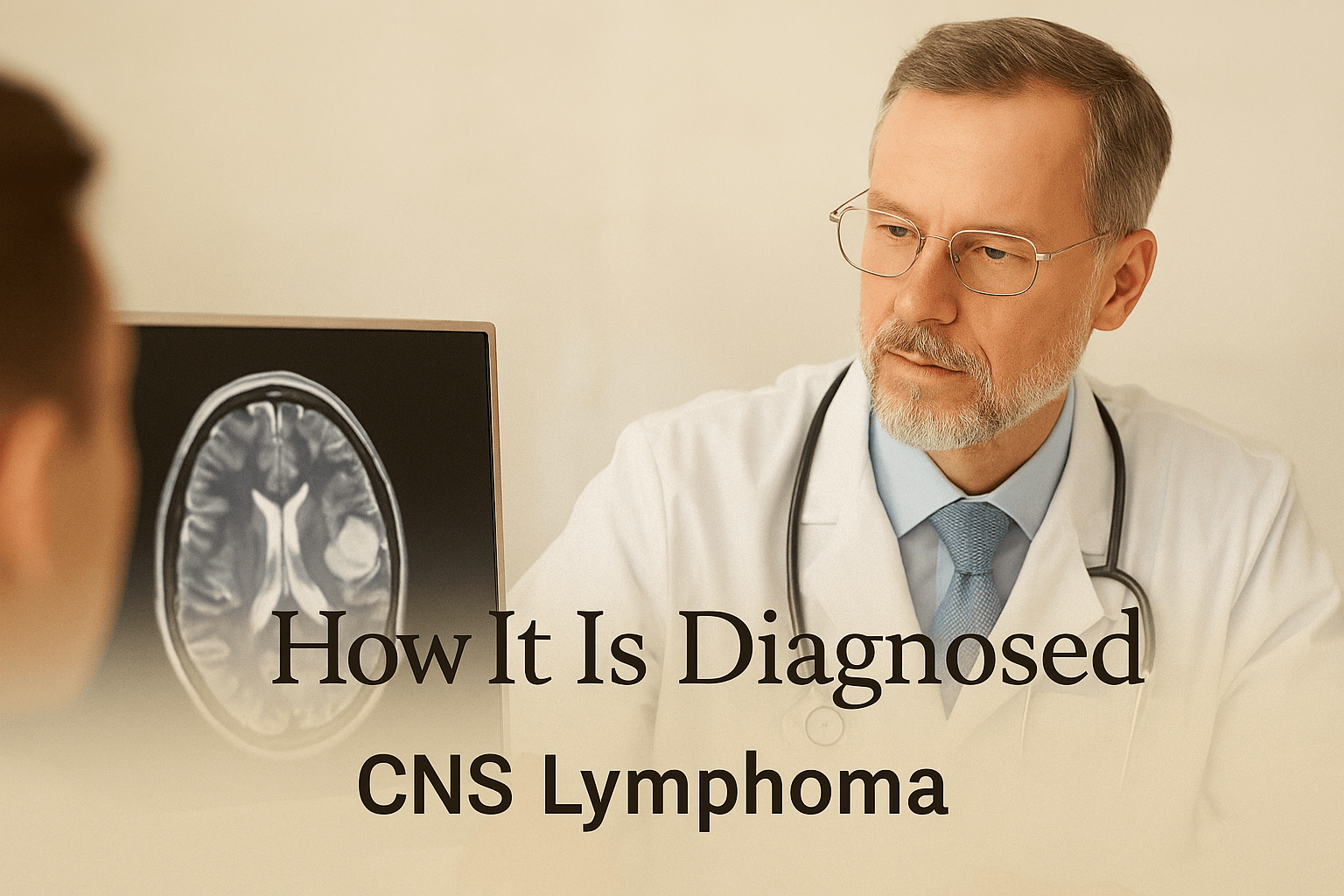
Medical Evaluation
Diagnosis of Primary CNS Lymphoma begins with a comprehensive neurological examination assessing reflexes, strength, balance, coordination, and cognitive function [1] [2]. This helps identify which regions of the brain or spinal cord are affected. Because the disease can also involve the eyes, a detailed ophthalmologic evaluation is performed to detect ocular lymphoma, which may present as inflammation, floaters, or visual distortion [11] [12]. Fundoscopic and slit-lamp examinations help identify characteristic lesions or vitreous infiltration [13]. From an Ayurvedic perspective, early identification of neurological imbalances aligns with assessing Majjavaha Srotas dysfunction and Vata aggravation, which parallels modern neurological deficits.
Imaging Tests
Magnetic Resonance Imaging with contrast is the most sensitive and preferred test for CNS lymphoma [2] [3] [4]. MRI typically shows one or multiple enhancing lesions, often in deep brain structures such as the basal ganglia, corpus callosum, or periventricular white matter. The contrast enhancement helps distinguish lymphoma from infections or other brain tumors. If MRI is not available or contraindicated, a Computed Tomography scan may be used to reveal space-occupying lesions [5]. Positron Emission Tomography scans can also aid in assessing systemic involvement or differentiating recurrent disease from radiation necrosis [6].
Biopsy
A stereotactic brain biopsy remains the gold standard for confirming Primary CNS Lymphoma [7] [8]. A neurosurgeon extracts a small tissue sample using image guidance, which is then examined microscopically to identify malignant B-cells. Histopathology and immunohistochemistry typically reveal large atypical lymphoid cells positive for CD20 markers, confirming the diffuse large B-cell lymphoma subtype [9]. In Ayurveda, this detailed tissue identification corresponds to assessing Dhatu Dushti where Majja, representing the nervous tissue, shows structural and functional disturbance, reinforcing the need for Rasayana therapy to restore tissue integrity after treatment.
Lumbar Puncture
A lumbar puncture or spinal tap is performed to collect cerebrospinal fluid and detect malignant lymphocytes or viral DNA markers such as EBV [10] [12] [13]. CSF cytology and flow cytometry are especially important when the tumor is small or imaging findings are inconclusive. Measuring opening pressure and analyzing biochemical markers also helps differentiate lymphoma from infections or inflammatory conditions that present similarly.
Blood Tests
Blood tests are essential to evaluate immune function and systemic health. These include complete blood count, liver and kidney function tests, and lactate dehydrogenase (LDH) levels. An HIV test is recommended, as immunodeficiency significantly increases the risk of CNS lymphoma [11] [14]. Additional tests for EBV or hepatitis may be done depending on clinical suspicion. In Ayurveda, assessment of immune strength or Ojas and the vitality of each Dhatu helps understand how systemic depletion can lead to such malignancies. Rasayana and Ojas-strengthening therapies are then used to restore immune balance and nervous system stability following treatment.
Treatment Options with Side Effects
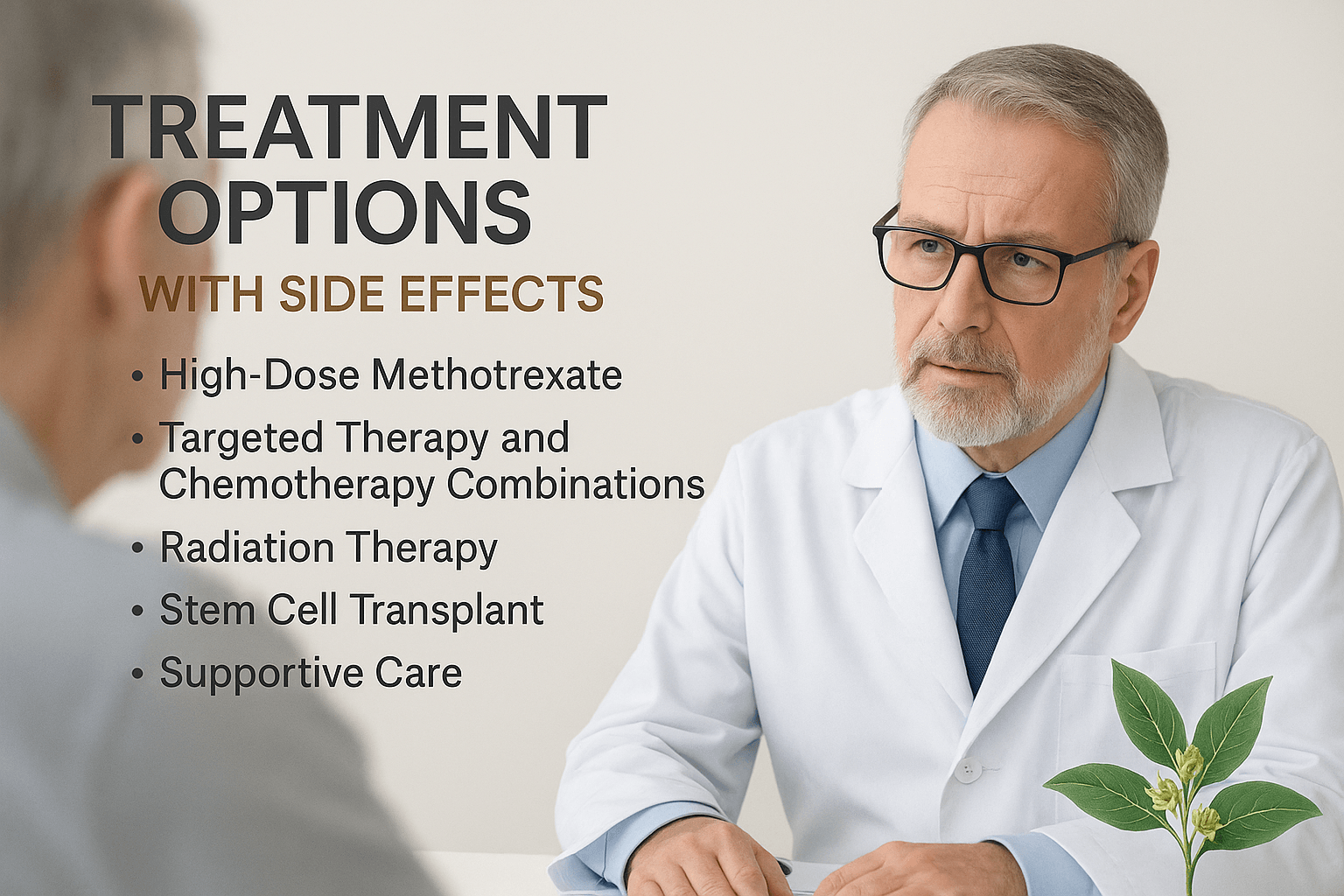
Standard Medical Treatments
High-Dose Methotrexate
High-dose methotrexate remains the first-line treatment for Primary CNS Lymphoma [1] [2]. It is administered intravenously, typically every one to two weeks, in cycles lasting several months depending on the patient’s response. Methotrexate is preferred because it effectively crosses the blood brain barrier and targets malignant lymphocytes in the central nervous system [3]. However, its high dosage requires strict renal and hepatic monitoring. Potential side effects include kidney dysfunction, elevated liver enzymes, oral ulcers, fatigue, and nausea [4] [5]. Patients often receive intravenous fluids and leucovorin rescue therapy to minimize toxicity.
Targeted Therapy and Chemotherapy Combinations
Chemotherapy regimens often include combinations such as methotrexate with Rituximab, Cytarabine, or Temozolomide [6] [7]. Rituximab is a monoclonal antibody that targets CD20-positive B-cells, improving response rates and remission durability [8]. Cytarabine and temozolomide enhance tumor control but may cause bone marrow suppression, anemia, hair loss, or increased infection risk [9]. Combination regimens are tailored based on patient age, performance status, and comorbidities to balance efficacy and toxicity.
Radiation Therapy
Radiation therapy, particularly whole-brain radiation, is used either after chemotherapy or when chemotherapy is contraindicated [10] [11]. It can effectively reduce tumor size but carries the risk of delayed cognitive impairment, memory loss, and radiation-induced leukoencephalopathy [12] [13]. These effects are especially pronounced in older adults. Newer approaches, such as reduced-dose radiation or localized stereotactic radiotherapy, aim to limit these long-term side effects while maintaining disease control.
Stem Cell Transplant
For younger or relapsed patients, autologous stem cell transplantation may be considered after achieving remission with chemotherapy [14] [15]. This involves collecting the patient’s own stem cells, administering very high-dose chemotherapy to destroy remaining malignant cells, and then reintroducing the stem cells to restore bone marrow function. Though potentially curative in selected cases, it carries significant risks including infection, bleeding, and organ toxicity [16] [17].
Prognosis
Survival Rates
The prognosis of Primary CNS Lymphoma has improved considerably over the past two decades due to advancements in chemotherapy, targeted therapy, and supportive care [1] [2]. With modern high-dose methotrexate–based regimens, median overall survival has increased to 5–8 years, and complete remission can be achieved in 40–60% of patients [3] [4]. Younger patients with normal immune function and early diagnosis often experience the best outcomes, while immunocompromised individuals tend to have shorter survival spans [5] [6]. Studies also indicate that combination therapies using methotrexate, rituximab, and cytarabine yield better disease control and lower recurrence rates than single-drug regimens [7] [8]. Early initiation of treatment significantly enhances both remission probability and quality of life. Ayurvedic Rasayana therapies may complement recovery by restoring Ojas and Majja Dhatu balance, supporting post-therapy immune resilience and cognitive function.
Factors Affecting Outcomes
Age plays a crucial role in determining prognosis. Patients under sixty years tend to respond more favorably to high-dose methotrexate and combination therapy [4] [6]. Older patients often have reduced tolerance to aggressive regimens and may require modified dosing or supportive interventions [9].
HIV status is another major determinant. Individuals living with HIV generally exhibit more aggressive disease courses and poorer responses compared to immunocompetent patients [11] [14]. However, the introduction of antiretroviral therapy has improved survival rates in this subgroup [13] [14].
Performance status at diagnosis, reflecting the patient’s neurological function and general health, strongly influences outcomes. Patients who present with minimal neurological impairment tend to recover faster and maintain functional independence longer [3] [6] [8].
Response to methotrexate-based therapy remains the most significant prognostic factor. Those achieving complete radiological remission after induction therapy have the highest chance of long-term survival [1] [3] [7]. Conversely, non-responders or those with relapse after initial remission require alternative therapies such as high-dose chemotherapy with stem cell rescue or targeted biologics.
From an Ayurvedic perspective, prognosis is guided by the strength of Agni, the balance of Tridosha, and the integrity of Ojas and Majja Dhatu. Early detection and a restorative regimen that includes Rasayana and Satvavajaya (mental rejuvenation therapy) enhance vitality and improve outcomes when integrated with modern oncological care.
Ayurvedic Perspective
From an Ayurvedic viewpoint, Primary CNS Lymphoma can be understood as a deep-seated disturbance involving the Kapha, Meda, and Majja Dhatus. These tissues govern structural integrity, lubrication, and neurological stability. When Kapha and Meda accumulate excessively, and Majja becomes depleted or vitiated, it leads to abnormal cellular proliferation and loss of immune intelligence within the nervous system. The Raktavaha and Majjavaha Srotas, which regulate nourishment and neural signaling, become obstructed and weakened, creating an internal environment conducive to disease manifestation [30] [31].
Classical references also compare such conditions to Abhishyanda, a disorder marked by inflammation and congestion within delicate channels. In this context, chronic immune depletion and accumulation of toxins parallel what Ayurveda describes as Oja-Kshaya, the loss of vital immune energy [32]. This depletion makes the body more vulnerable to cellular imbalances and degeneration, aligning with the modern understanding of immune suppression seen in CNS lymphoma.
Ayurvedic Goals
The therapeutic goals in Ayurveda for CNS disorders such as lymphoma are centered on enhancing immune strength, supporting Majja Dhatu (nervous tissue) regeneration, improving quality of life, and reducing treatment-related side effects like fatigue, nausea, and cognitive stress [33] [35]. Treatment does not replace oncology protocols but complements them by improving resilience, reducing toxicity, and promoting recovery. Rejuvenation of Ojas and restoration of Dhatu balance are key objectives.
Ayurveda emphasizes addressing both the root cause (Nidana Parivarjana) and the systemic imbalance (Dosha Prashamana). Through this approach, the therapies aim not only to manage the condition but also to strengthen the patient’s vitality and cognitive clarity during and after chemotherapy or radiation.
Suggested Ayurvedic Approaches
Ayurvedic management should always be conducted alongside oncological supervision. The cornerstone of care includes Rasayana therapy, which enhances immunity, improves brain tissue nourishment, and supports long-term recovery. Herbs with Medhya (neurocognitive) and anti-inflammatory properties are particularly valuable. Gentle Panchakarma procedures, such as Shirodhara or Basti, may be considered in select cases only after careful evaluation of strength, stage, and ongoing medical treatment. These therapies are optional and should never interfere with chemotherapy or other active interventions.
Key Herbs (Supportive Role)
Ashwagandha (Withania somnifera): Strengthens Ojas, reduces fatigue, and improves stress tolerance. Demonstrated neuroprotective and immune-modulating activity in preclinical and clinical studies [33].
Brahmi (Bacopa monnieri): Enhances cognition, memory, and concentration while reducing oxidative stress within neural tissue [35] [36].
Guduchi (Tinospora cordifolia): Known as a Rasayana herb that boosts immunity and detoxifies the system. Modern studies validate its role in improving lymphocyte function and reducing inflammatory cytokines [34].
Shatavari (Asparagus racemosus): Restores vitality, supports hormonal balance, and aids tissue repair through its adaptogenic and antioxidant properties.
Turmeric (Curcuma longa): Exhibits anti-inflammatory, antioxidant, and anticancer effects. Curcumin has been shown to inhibit malignant cell proliferation and reduce therapy-induced inflammation [37].
These herbs may be delivered in powder, decoction, or Avaleha (herbal jam) form depending on individual constitution, digestive strength, and ongoing treatments.
Nutrition & Lifestyle
Diet and lifestyle form the foundation of healing. A Satvik diet, rich in freshly cooked, plant-based meals, supports clarity and tissue regeneration. Easily digestible foods like rice gruel, lentil soup, and ghee help reduce Ama (toxic residue) and restore metabolic balance. Foods that are too oily, processed, or fermented should be minimized.
Regular Yoga and Pranayama support oxygenation, lymphatic flow, and nervous system balance. Gentle practices like Anulom Vilom and Bhramari Pranayama calm the mind and improve brain oxygenation. Meditation and guided relaxation techniques can significantly reduce anxiety and improve emotional resilience during cancer therapy.
From a holistic standpoint, Ayurveda views healing as a union of body, mind, and spirit. By maintaining balance across these dimensions, patients can recover with greater strength, stability, and peace of mind while continuing essential oncological treatment.
Brahma Rasayana (Main Medicine To Heal)

A classical brain and immunity-restoring herbal jam for Majja Dhatu (nervous tissue), Ojas (vital essence), and overall body rejuvenation. Ideal for those recovering from serious immune-depleting conditions or chronic weakness following chemotherapy, radiation, or prolonged illness.
Purpose
This Rasayana helps:
- Strengthen brain and nerve tissues
- Improve immune power (Ojas)
- Calm anxiety, improve sleep, memory, and focus
- Reduce fatigue, nausea, and mental fog from heavy treatments
- Support cellular regeneration and longevity
Ingredients (for 30-day use, 15 g twice daily)
Base Decoction (Kashaya Dravya)
- Amalaki (Emblica officinalis) – 1 kg – The main Rasayana fruit; cleanses, rejuvenates, and repairs tissues.
- Brahmi (Bacopa monnieri) – 200 g – Enhances memory and nerve regeneration.
- Shankhapushpi (Convolvulus pluricaulis) – 200 g – Calms the mind, relieves nervous strain.
- Guduchi (Tinospora cordifolia) – 150 g – Boosts immunity and detoxifies.
- Mandukaparni (Centella asiatica) – 100 g – Improves circulation to the brain.
- Haritaki (Terminalia chebula) – 100 g – Detoxifying and digestive tonic.
- Vibhitaki (Terminalia bellirica) – 100 g – Improves nutrient absorption.
- Yashtimadhu (Glycyrrhiza glabra) – 100 g – Soothes nerves and supports adrenal recovery.
- Jatamansi (Nardostachys jatamansi) – 100 g – Deeply calming and neuroprotective.
- Ashwagandha root (Withania somnifera) – 200 g – Strengthens muscles, nerves, and immunity.
All herbs are boiled in 5–6 liters of water and reduced to about 1 liter of thick decoction.
Powders to be Added Later
- Shatavari (Asparagus racemosus) – 100 g – Nourishes and cools the system.
- Pippali (Piper longum) – 25 g – Enhances absorption and Rasayana effect.
- Turmeric (Curcuma longa) – 25 g – Anti-inflammatory and antioxidant.
- Vacha (Acorus calamus) – 25 g – Improves clarity, speech, and brain activity.
- Trikatu (Pippali, Maricha, Shunthi – 10 g each) – Helps digestion and metabolism.
- Kantakari (Solanum xanthocarpum) – 50 g – Supports respiratory and immune systems.
- Musta (Cyperus rotundus) – 25 g – Digestive and anti-inflammatory.
Mineral Rasayana (added at 40°C)
- Heerak Bhasma (Diamond ash) – 250 mg – Cellular rejuvenator; improves DNA repair and longevity.
- Swarna Bhasma (Gold ash) – 500 mg – Boosts Ojas, immunity, and intellect.
- Rajat Bhasma (Silver ash) – 250 mg – Nervine tonic and mental stabilizer.
- Abhrak Bhasma (Purified Mica) – 1 g – Oxygenates cells and improves energy.
- Swarna Makshik Bhasma (Gold–Copper–Iron complex) – 500 mg – Enhances vitality and tissue healing.
- Trivanga Bhasma (Lead, Tin, Zinc calx) – 500 mg – Restores hormonal and metabolic balance.
- Mukta Sukti Bhasma (Pearl shell ash) – 500 mg – Soothes the brain and calms Pitta.
- Praval Pishti (Coral calcium) – 500 mg – Strengthens bones and nerves.
- Sphatik Bhasma (Alum ash) – 250 mg – Purifies and balances doshas.
- Lauh Bhasma (Iron ash) – 500 mg – Improves blood and oxygenation.
Ghee and Sweetening Agents
- Pure Cow’s Ghee – 250 ml – Enhances absorption of Rasayana principles.
- Organic Jaggery – 1.2 kg – Natural sweet base, balances herbs.
- Raw Honey – 150 ml (add after cooling) – Preserves and enhances the final product.
Preparation Method
- Prepare the Decoction:
Combine all base herbs in a large vessel with 5–6 liters of water. Boil gently on low flame until it reduces to about 1 liter. Strain through a clean cloth to remove solid parts. - Mix with Jaggery and Cook:
Add jaggery to the filtered decoction and heat on low flame. Stir continuously to prevent burning until the mixture becomes thick and sticky like honey. - Add Ghee and Powders:
Once the mixture starts to thicken, slowly add ghee and stir well. Then add the powdered herbs and continue cooking on low flame until a uniform jam-like consistency is achieved. - Cool and Add Minerals:
Allow the mixture to cool down to about 40°C (warm but not hot). Now add all Bhasmas (minerals) and mix gently with a wooden ladle. - Add Honey:
Once completely cool, mix honey thoroughly to finish the Avaleha. Store in a glass jar away from sunlight and moisture.
Dosage
Take 15 grams (1 tablespoon) twice a day after meals with warm milk or water for 30 days, unless advised otherwise by your physician.
Precautions and Supervision Guidelines
Brahma Rasayana (Enhanced Majja–Ojas Avaleha) is a powerful Rasayana formulation containing potent herbs and minerals such as Heerak Bhasma, Swarna Bhasma, Abhrak Bhasma, and Trivanga Bhasma. Because of its deep tissue action and influence on immune and nervous systems, it must always be prepared and administered under the direct supervision of a qualified Ayurvedic physician.
The composition and dosage of this Avaleha vary depending on multiple clinical and individual factors. Self-preparation or unsupervised intake can lead to imbalance or unwanted reactions.
Key Factors That Influence Formulation and Dosage
- Age: Younger patients may require lighter, non-metallic formulations, while adults can tolerate classical Rasayana preparations.
- Body Constitution (Prakriti):
- Vata-dominant individuals may need more unctuous and grounding herbs (e.g., Shatavari, Ghee).
- Pitta-dominant individuals require cooling agents (e.g., Mukta Sukti, Praval Pishti).
- Kapha-dominant individuals benefit from metabolism-stimulating herbs (e.g., Pippali, Trikatu).
- Vata-dominant individuals may need more unctuous and grounding herbs (e.g., Shatavari, Ghee).
- Disease Stage: The dosage and presence of mineral Bhasmas differ between early-stage weakness, recovery stage, or chronic degenerative conditions.
- Immune Status (Ojas level): Those with severe immune depletion (post-chemotherapy, HIV, or chronic infections) require gradual Rasayana initiation to prevent detox overload.
- Liver and Kidney Function: Since Bhasmas are metabolized through these organs, pre-existing liver or renal conditions necessitate dose modification.
- Current Allopathic Medications: Interactions can occur with chemotherapy, antivirals, or immunosuppressants. Close coordination between treating doctors is essential.
- Digestive Strength (Agni): Weak digestion or excessive Ama requires preliminary Deepana–Pachana therapy before Rasayana administration.
- Geographical and Seasonal Factors: Climate and diet influence absorption and tolerance. For instance, ghee-heavy Rasayana may be reduced in hot climates.
- Gender and Hormonal State: Women during pregnancy, menstruation, or lactation require specific substitutions or deferment of mineral components.
- Mental State and Sleep Patterns: Patients with anxiety, insomnia, or emotional instability benefit from added Medhya herbs (e.g., Jatamansi, Brahmi).
- Other Systemic Disorders: Diabetes, thyroid issues, and cardiovascular diseases require careful glycemic and metabolic monitoring during therapy.
FAQs
1. What is Brahma Rasayana Avaleha used for?
Brahma Rasayana Avaleha is used to strengthen the brain, nerves, and immune system. It helps reduce fatigue, anxiety, brain fog, and weakness after chemotherapy or long illness while improving overall vitality and mental focus.
2. Can I prepare it at home?
No. It must be prepared only under Ayurvedic doctor supervision. The ingredients and minerals such as Swarna Bhasma, Heerak Bhasma, and Abhrak Bhasma need professional purification and proportioning that vary by patient condition.
3. Is it safe for everyone?
It is generally safe when prescribed properly, but the formulation differs depending on age, Prakriti, disease stage, liver or kidney health, and medications being used. Self-use is not advised.
4. Can I take it with modern medicines?
Yes, but only under the supervision of your physician. Coordination between Ayurvedic and modern doctors is necessary to avoid any unwanted drug interactions, especially during chemotherapy or immunosuppressive therapy.
5. How long should Brahma Rasayana be taken?
Usually for 30 days, but the duration can extend up to three months depending on clinical response and recovery stage. It is often followed by a short rest period before restarting.
6. What diet should I follow while taking it?
Eat light, fresh, and easily digestible food. Avoid spicy, oily, or processed food. Include ghee, milk, fruits, and vegetables to support Rasayana absorption and digestion.
7. Are there any side effects?
When properly prepared and prescribed, it rarely causes side effects. Mild heaviness or digestive discomfort can occur if taken in excess or on an empty stomach.
8. Can it be used during ongoing cancer treatment?
Yes, but only after your oncologist and Ayurvedic doctor agree on timing and dose. It is often started after active chemotherapy cycles to restore strength and immunity.
9. Is Panchakarma necessary before taking this Avaleha?
Not always. In weak or recovering patients, gentle Rasayana therapy is preferred. Panchakarma is optional and used only after careful evaluation of strength and tolerance.
10. How should it be stored?
Keep it in a glass container, tightly closed, away from sunlight and moisture. Do not refrigerate. It stays effective for about six months if handled properly.
Final Master Reference List
Modern Oncology & Neurology Sources
[1] Grommes, C., & DeAngelis, L. M. (2017). Primary CNS lymphoma. Journal of Clinical Oncology, 35(21), 2410–2418. https://doi.org/10.1200/JCO.2017.73.7602
[2] Ferreri, A. J. M., et al. (2024). EHA–ESMO Clinical Practice Guideline for PCNSL. Annals of Oncology. https://pmc.ncbi.nlm.nih.gov/articles/PMC11148853/
[3] EANO Task Force. (2022). European Association of Neuro-Oncology guideline for PCNSL. Neuro-Oncology. https://pmc.ncbi.nlm.nih.gov/articles/PMC9825335/
[4] National Cancer Institute. (2025). PCNSL Treatment (Physician Guide). https://www.cancer.gov/types/lymphoma/hp/primary-cns-lymphoma-treatment-pdq
[5] National Cancer Institute. (2023). PCNSL Treatment (Patient Guide). https://www.cancer.gov/types/lymphoma/patient/primary-cns-lymphoma-treatment-pdq
[6] Puhakka, I., et al. (2022). Primary CNS lymphoma incidence & outcomes: Finland study. BMC Cancer. https://doi.org/10.1186/s12885-022-09315-8
[7] Macmillan Cancer Support. (2024). Primary CNS lymphoma. https://www.macmillan.org.uk
[8] Cancer Research UK. (2024). Brain & spinal lymphoma. https://www.cancerresearchuk.org
[9] American Brain Tumor Association. (2024). CNS Lymphoma Fact Sheet. https://www.abta.org
[10] Cleveland Clinic. (2023). CNS Lymphoma overview. https://my.clevelandclinic.org/health/diseases/23474-cns-lymphoma
Etiology: EBV, HIV, Immunosuppression
[11] Bayraktar, S., et al. (2010). PCNSL in HIV vs non-HIV. Journal of Neuro-Oncology. https://doi.org/10.1007/s11060-010-0334-6
[12] Kaulen, L. D., et al. (2023). EBV-positive PCNSL characteristics. Cancers. https://doi.org/10.3390/cancers15010234
[13] Cinque, P., et al. (2004). EBV DNA in CSF predicting PCNSL in HIV-patients. Clinical Infectious Diseases. https://doi.org/10.1086/425001
[14] Mahale, P., et al. (2018). HIV infection & CNS lymphoma. Cancer Epidemiology. https://doi.org/10.1016/j.canep.2018.03.014
Symptoms & Clinical Features
[15] Blood Cancer UK. (2024). PCNSL symptom guidance. https://bloodcancer.org.uk
[16] MD Anderson Cancer Center. (2024). CNS lymphoma overview. https://www.mdanderson.org
Diagnosis: MRI, Biopsy, Eye Evaluation, CSF Markers
[17] Haldorsen, I. S., et al. (2011). MRI features of PCNSL. AJNR. https://doi.org/10.3174/ajnr.A2418
[18] Lin, X., et al. (2017). Dynamic contrast MRI accuracy. AJNR. https://doi.org/10.3174/ajnr.A5030
[19] Zhao, H., et al. (2019). Stereotactic biopsy & CSF cytology. Oncology Letters. https://pmc.ncbi.nlm.nih.gov/articles/PMC6505083/
[20] Au, K. L. K., et al. (2020). CSF flow cytometry in CNS lymphoma. CJNS. https://doi.org/10.1017/cjn.2020.18
[21] Wang, S.-Y., et al. (2025). Primary vitreoretinal lymphoma update. Eye and Vision. https://doi.org/10.1186/s40662-025-00402-y
Treatment: High-Dose MTX, MATRix, ASCT, WBRT
[22] Ferreri, A. J. M., et al. (2016). IELSG32 MATRix trial. The Lancet Haematology. https://doi.org/10.1016/S2352-3026(16)00036-3
[23] Ferreri, A. J. M., et al. (2021). MATRix-RICE + ASCT. Lancet Haematology. https://doi.org/10.1016/S2352-3026(21)00193-6
[24] Yamada, Y., et al. (2022). HD-MTX dose optimization. Neuro-Oncology Advances. https://doi.org/10.1093/noajnl/vdab064
[25] CALGB 50202 trial results summary (Alliance). https://www.ncbi.nlm.nih.gov/books/NBK65893/
[26] ASTRO. (2023). WBRT effects & cognition. https://www.astro.org
Prognosis & Survivorship
[27] Soussain, C., et al. (2014). Long-term outcomes in PCNSL. Neuro-Oncology. https://doi.org/10.1093/neuonc/not304
[28] van der Meulen, M., et al. (2017). PCNSL survival data. Leukemia. https://doi.org/10.1038/leu.2017.39
[29] Martínez-Calle, N., et al. (2020). Elderly prognosis. British Journal of Haematology. https://doi.org/10.1111/bjh.16519
Ayurveda Classical Citations
[30] Charaka Samhita — Chikitsa Sthana, Chapter 1 (Rasayana Adhyaya). Chaukhambha Sanskrit Series.
https://www.carakasamhitaonline.com/index.php?title=Rasayana_Adhyaya
[31] Ashtanga Hridaya — Uttara Tantra, Chapter 39 (Rasayana).
https://archive.org/details/AstangaHrdayam.Eng
[32] Bhavaprakasha Nighantu — Medhya & Rasayana Varga.
https://archive.org/details/in.ernet.dli.2015.347520
Modern Rasayana, Immunity & Neuro-Protection Research
[33] Mikulska, P., et al. (2023). Ashwagandha immune/neuro support. J Clin Med. https://doi.org/10.3390/jcm12165162
[34] Gupta, A., et al. (2024). Tinospora cordifolia immunology. Heliyon. https://pmc.ncbi.nlm.nih.gov/articles/PMC10882059/
[35] Kulkarni, R., et al. (2012). Medhya Rasayana review. Pharmacognosy Reviews. https://doi.org/10.4103/0973-7847.99946
[36] Calabrese, C., et al. (2008). Bacopa cognitive RCT. JACM. https://pmc.ncbi.nlm.nih.gov/articles/PMC3153866/
[37] Hewlings, S., & Kalman, D. (2017). Curcumin review. Foods. https://pmc.ncbi.nlm.nih.gov/articles/PMC5664031/
[38] AYUSH Ministry. (2024). Safety monographs: Rasayana herbs. https://ayush.gov.in
Holistic, Emotional, & Functional Recovery
[39] American Brain Tumor Association. Patient guide. https://www.abta.org
[40] Blood Cancer UK. Rehabilitation after lymphoma. https://bloodcancer.org.uk





